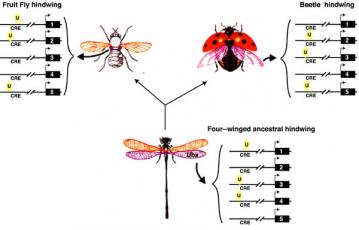Mutation is a crucial component of evolution, as is natural selection. In focusing exclusively on those two mechanisms, Explore Evolution ignores other critical evolutionary mechanisms. Despite those omissions, the book's coverage of mutation is woefully inadequate. "Mutation" itself is misdefined, ways in which mutations influence morphology are omitted, and the effects of mutations on fitness are mischaracterized. Scientists views are described inaccurately, creationists are passed off as legitimate sources and even plagiarized.
In its discussion of developmental biology, the chapter carries out the predictions of biologist Rudolf Raff: "we will see more slick books of bogus science produced to influence the teaching of biology Evo-devo data have become a part of the creationist rhetorical weaponry, and as evo-devo grows in prominence, the problem will grow in severity." Again, baic knowledge is misrepresented, scientists are misquoted, and students are left without the resources necessary to conduct their own inquiry into one of the most exciting new fields in biology.
p. 98: "Mutations can occur when genes are exposed to heat, chemicals, or radiation"
This is not an exhaustive list of causes of mutation. Errors in DNA copying and chromosomal crossing-over are more significant causes.
p. 101: "structural mutations" are mutations which "ultimately affect an animal's shape or structure"
 Evolution of hindwings: Mutations in regulatory genes change the shapes of insect hindwings
Evolution of hindwings: Mutations in regulatory genes change the shapes of insect hindwings Structural mutations are those which change the structure of a protein, not which change an organism's morphology. This is a trivial misdefinition.
p. 109: "no experimental mutations in hox genes have proven helpful"
This is a young field, and the absence of evidence would not be evidence that no such mutations exist.
p. 103: Antibiotic resistance "mutation impairs [bacterial] ability to perform vital functions"
Compensatory mutations reverse such impairments, and they do not always occur.
p. 103: "The cell cannot endure an unlimited number of mutations"
Many mutations can be tolerated by a cell, and an infinite number is not necessary.
p. 103: "multiple mutations at active sites inevitably do more harm than good"
Compensatory mutations can and do increase fitness.
p. 107: "a reptile laid an egg from which a bird was hatched two-legged sheep or two-headed turtles"
These odd phrases, and many others on this page, are plagiarized from creationist David Menton.
p. 109: "temperature changes" cause "a whole new fitness cost"
Fitness is always relative to an environment. Changing temperature changes fitness, and may either increase or decrease an organism's fitness.
p. 110: "DNA does not direct how the overall body plan gets built"
This is contrary to the best current research, and is unsupported by the evidence offered.
p. 111: "many scientists doubt that [higher-level assembly instructions] are stored in DNA alone"
The authors cited to support this claim actually dispute it. Alternatives offered are still producedstructured by DNA sequences.
p. 110: "Critics say it's a little like building a CD player."
This analogy makes no sense, and has only ever been offered by creationist sources.
p. 111: "you can mutate DNA 'til the cows come home and you still wouldn't get a new body plan"
The citation offered to support the claim actually rejects this conclusion.
p. 106: "Major mutations &hellip are always harmful or outright lethal"
The authors cited supporting this claim actually reject it. The results may be "tiny, moderate, or large."
p. 104: "In every case resistance results from small changes to a single protein molecule"
This is not always true.
p. 105: "there is no evidence that one species of bacteria has changed into another"
This is false. New bacterial species have been produced in the lab.
Major Flaws:
Mutations: Mutation is misdefined, major types of mutation are omitted, and the effects of mutation on fitness are mischaracterized. For a chapter about mutation, these basic failures are fairly significant.
DNA: The role of DNA in development is described incorrectly throughout. It has been clear for decades that DNA ultimately controls morphology and development. Explore Evolution wrongly obscures this basic truth.
Morphology: The study of evolutionary changes in morphology evolutionary developmental biology is an exciting and rapidly-changing field. Explore Evolution confuses this field, giving students too little background to understand this new field, and misinformiag them about the basics of this dynamic field.
